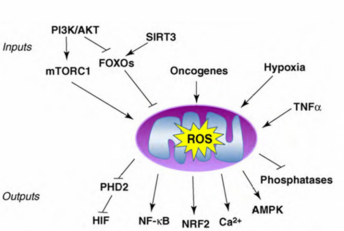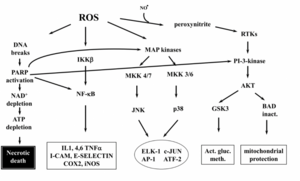22. Oxidative stress induced signaling pathway
Reactive oxygen species like OH°, O2°– and H2O2 are harmful to every cell in the body by increasing the oxidative stress in the cell. The presence of these molecules in a cell elicits a response by the cell. This response aims to reduce the number of these ROS by upregulating genes for antioxidant proteins that can neutralize the reactive molecules, or by inducing an inflammatory response.

Many factors can increase the number of ROS in a cell. Most of them originate from the mitochondria as by-products of the oxidative phosphorylation. An increased activation of the mitochondria will therefore increase the number of ROS. Hypoxia, TNFα, and PKB are all factors that can increase the ROS output from the mitochondria.
A type of transcription factors called FOXO suppresses the ROS production. However, PKB inhibits FOXO and thereby increases ROS output. Two proteins called SIRT1 and SIRT3 activate FOXO and thereby decrease the ROS output. You can read more about SIRT in topic 14.
The pathways
Reactive oxygen species cause activation of five pathways, which either induce cell death, inflammation or the increased production of anti-oxidants.
The first pathway is the induction of PARP. ROS cause DNA damage. Recall that the enzyme called PARP detects DNA damage and causes NAD+ and ATP depletion. This will eventually cause necrosis, or necrotic cell death.

The second pathway is the activation of the transcription factor NF-κB. ROS activate IKKβ, which is a protein that activates NF- κB. NF-κB will then induce the transcription of many pro-inflammatory cytokines and molecules, like TNFα, IL-1, IL-6, COX2 and iNOS.
The third pathway is the activation of a protein called Ask1, which will activate the MAP kinase pathway. We don’t have to know the details, but it ends with apoptosis.
The fourth pathway is the activation of PKB. PKB will inhibit GSK3 which will induce a metabolic adaptation of the cell. PKB also phosphorylates and deactivates the pro-apoptotic protein BAD, inhibiting apoptosis.

The last and most important pathway is the Nrf2 pathway. A transcription factor called Nrf2 binds to a part of the DNA called the Antioxidant Response Element (ARE). After binding the ARE Nrf2 will induce transcription of many genes that increase antioxidant production, like genes for the glutathione synthesis, NADPH synthesis and other genes for the elimination of ROS.
When there is no oxidative stress, Nrf2 is bound to a protein called Keap1, which inhibits Nrf2. Keap1 will then target Nrf2 for ubiquitination and degradation. When there is oxidative stress however, Keap1 will not inhibit Nrf2 so Nrf2 can migrate into the nucleus and do its job as a transcription factor. This regulation mechanism is similar to the one of HIF-1α.
The initial effect of Nrf2 is protective to the cell, but during prolonged activation, such as in the case of chronic oxidative stress its effect will be harmful to the cell. During chronic oxidative stress a protein called Fyn will inhibit Nrf2.
